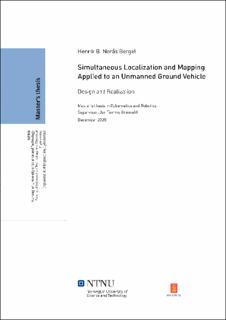| dc.contributor.advisor | Gravdahl, Jan Tommy | |
| dc.contributor.author | Bergel, Henrik B. Norås | |
| dc.date.accessioned | 2021-09-23T18:20:51Z | |
| dc.date.available | 2021-09-23T18:20:51Z | |
| dc.date.issued | 2020 | |
| dc.identifier | no.ntnu:inspera:66462738:20979883 | |
| dc.identifier.uri | https://hdl.handle.net/11250/2781013 | |
| dc.description.abstract | Denne oppgaven presenterer arbeidet med å designe og bygge det Ubemannede Kjøretøyet (UK), Phylax. Oppgaven undersøker også muligheten for å bruke GMapping som metode i et Simultan Lokalisering og Kartlegging's (SLOK) system. De eksisterende SLOK metodene har forskjellige kompromisser når det gjelder kompleksitet, kostnad og nøyaktighet. GMapping har tidligere vist lovende resultater i kostnad og nøyaktighet ved bruk i SLOK systemer som utforsker innendørs omgivelser. Å bidra i utviklingen av den autonome evnen til en UK ved å utnytte SLOK var en motiverende faktor for arbeidet.
Bidraget til denne oppgaven er Phylax-plattformen, samt en undersøkelse av ytelsen til et utviklet SLOK system som drar nytte av SLOK metoden GMapping. Phylax kan både bli kontrollert eksternt av en bruker, eller operere fullstendig autonomt. UK vil anskaffe nødvendig Inertiell Målingsenhets (IM) data, odometridata og lidardata som SLOK systemet kan bruke til å estimere et kart av omgivelsene med. Programvaren til Phylax ble implementert i rammeverket Robot Operativ System (ROS), ved bruk av programmeringsspråkene C++ og XML.
SLOK systemet ble testet på to datasett som Phylax samlet inn innendørs. Det første datasettet var basert på et rom kun bestående av vegger og et flatt gulv. Dette datasettet ble fungerende som et referansesett. Det andre datasettet ble samlet inn i det samme rommet, men nå også med en hinderløype. Før eksperimentet ble gjennomført, ble odometrien til Phylax kalibrert ved a sammenligne verdiene i et ROS emne med den faktiske kjørte distansen.
Resultatene fra SLOK systemet er entydige. GMapping estimerer nøyaktige kart basert på referansedatasettet. Kartene basert på datasettet fra hinderløypen gav imidlertid utilstrekkelige resultater. Relevant informasjon ble utelatt fra kartet, noe som gjorde autonom navigasjon i det gitte miljøet vanskelig. Phylax fungerte utmerket og datainnslamlingen var vellykket. Imidlertid er det mulige feil i de midterste motorene som kan påvirke odometriutregningene. Transformasjonene mellom koordinatsystemene kan også inneholde unøyaktige målinger av distansen mellom systemene. Disse feilene kan spre seg videre inn i systemet og føre til at GMapping estimerer kart basert på feil data.
Oppgaven konkluderte med at UK-plattformen ble designet og bygget med et suksessfullt resultat med mulighet for å samle inn data basert på sensorene: IM, odometri og lidar. SLOK systemet ble også riktig utviklet, men bruken av GMapping som SLOK metode bidro til en lav score på Autonomi Skalaen (AS). Derfor ble GMapping sett på som en utilstrekkelig SLOK metode for autonom navigering i terreng for en UK. | |
| dc.description.abstract | This Master's thesis presents the work of designing and building the Unmanned Ground Vehicle (UGV) platform, Phylax. It also investigates the possibility of using GMapping as the method in a Simultaneous Localization and Mapping (SLAM) system that estimates maps based on sensor data from Phylax. The existing SLAM methods all have different trade-offs in terms of complexity, cost and accuracy. GMapping has previously shown promising results in cost and accuracy in SLAM systems exploiting indoor environments. The contribution to the development of autonomous capabilities of a UGV by utilizing SLAM was the motivational factor.
The contribution of this thesis is the Phylax platform and an investigation of the performance of a developed SLAM system utilizing the SLAM method, GMapping. Phylax can both be controlled externally by a user, or operate fully autonomously. The UGV will acquire necessary Inertial Measurement Unit (IMU)-, odometry- and lidar data, which the SLAM system will use to estimate a map of the surrounding scenery. The software for Phylax was implemented in the framework Robot Operating System (ROS), using the programming languages C++ and Extensible Markup Language (XML).
The SLAM system was tested on two datasets that Phylax collected in an indoor environment. The first dataset was from a clean room only containing walls, and worked as the ground truth. The second dataset was acquired in an obstacle course built inside the same room. Prior to the experiment, the odometry in Phylax was calibrated by comparing the values in the ROS odometry topic with the actual traveled distance.
The results from the SLAM system are unambiguous. GMapping estimated accurate maps on the benchmark dataset. However, the maps from the obstacle course presented inadequate results. Relevant information was left out of the map, which made autonomous navigation, in that scenery, difficult. Phylax worked in a satisfactory way and the data acquisition was successful. However, there are possible errors in the middle motors that might affect the odometry calculations. Also, the transformation between coordinate frames may include inaccurate measurements for the translation. These errors could propagate into the system and cause GMapping to estimate a map based on erroneous data.
The thesis concluded that the UGV platform was successfully designed and built with the ability to collect datasets based upon the sensors: IMU, encoders and lidar. The SLAM system was also properly developed, but the use of GMapping as the SLAM method contributed to a low score on the level of autonomy (LOA) scale. Therefore, GMapping was concluded not to be suited as a SLAM method for autonomous navigation in terrain for a UGV. | |
| dc.language | eng | |
| dc.publisher | NTNU | |
| dc.title | Simultaneous Localization and Mapping Applied to an Unmanned Ground Vehicle: Design and Realization | |
| dc.type | Master thesis | |
